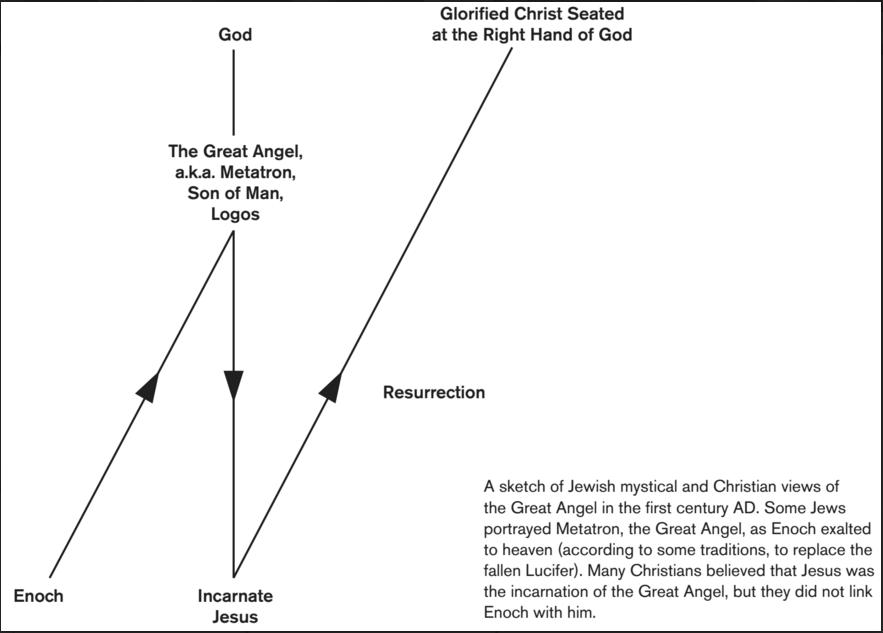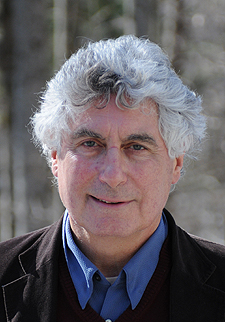God Only Knows
Printed in the Fall 2015 issue of Quest magazine.
Citation: Kinney, Jay."God Only Knows" Quest 103.4 (Fall 2015): pg. 137-139.
By Jay Kinney
 Finding something new and meaningful to say about the concept of God is a surprisingly difficult task. Philosophers and theologians have spent millennia wrestling with God, with little to show for it: your average man or woman on the street may believe in God in some fashion, but it is likely a belief derived from a handful of scriptural verses or from folk customs bereft of intellectual rigor. For most people, God just is — a core assumption around which further beliefs are built.
Finding something new and meaningful to say about the concept of God is a surprisingly difficult task. Philosophers and theologians have spent millennia wrestling with God, with little to show for it: your average man or woman on the street may believe in God in some fashion, but it is likely a belief derived from a handful of scriptural verses or from folk customs bereft of intellectual rigor. For most people, God just is — a core assumption around which further beliefs are built.
Those further beliefs may include ones such as these: God created the universe; God in his wisdom and glory deserves our worship and gratitude; God is all-knowing, all-seeing, all-powerful, and eternal; God has a “plan” that manifests in daily life (and in history); God has commandments or laws or preferred behaviors for which people are rewarded or punished, both in the here and now and in eternity.
If this list seems unduly tilted towards Western monotheism, that’s because it is. Because I lack God’s omniscience, my grasp of Hinduism, Buddhism, Taoism, Shintoism, and other Eastern religions is rudimentary at best. No matter how many times I have it explained to me, I still can’t quite grasp the cosmology behind the backroom shrines featuring red lightbulbs and fresh fruits that are omnipresent in Chinese-owned shops in the city in which I live (San Francisco). They are assisting departed relatives, I’ve been told, but exactly how and why eludes me.
So let us return to pondering God with the capital “G,” the source of so much comfort and strife for billions of people.
The comfort derives from the sense that someone or something greater than ourselves is in charge. As children, if we are so lucky, our parents fulfill this role, which can explain why we later project the parental role onto God the Father (or, more rarely, the Mother).
In similar fashion, for most of human history, societies have been ruled by kings and queens, or tribal leaders, chiefs, or warlords — essentially the alpha dogs leading the pack. This quality too has been projected onto God as Lord or Christ as King.
Churches, then, serve the function of royal courts, with believers as courtiers and supplicants praising their sovereign and requesting favors in return.
While this arrangement may seem infantile or retrograde to the modern egalitarian sensibility, one suspects that it may be hard-wired into us. After all, most democracies elect presidents or prime ministers who play the role of political figurehead and chief scapegoat.
God and religion thus serve the function of providing a meaningful structure to people’s lives and a moral code to live by. The strife that these can also cause would seem to derive from the human propensity to view competing belief systems, deities, and sects as threatening enemies worthy of extermination — or at least banishment to the hinterlands.
Still, even in the midst of chaotic, human-engineered strife, the stability of the rhythms and cycles of nature and the heavens have persuaded us that there is an overarching order to the universe. Thus the beginnings of modern science can be traced to the belief that God created this order and the laws of nature, and that studying the working of those laws could bring us to a better understanding of God. That’s what motivated Isaac Newton’s scientific investigations, though Newton also tried working it in the opposite direction — hoping that a study of the scripturally recorded dimensions of Solomon’s Temple might shed light on natural law.
Over time it was probably inevitable that the scientific study of nature would avoid trying to fit God into the picture and that the emphasis on the orderly laws of nature would leave little room for miracles — “supernatural” events that seemingly violated those laws. By the time that Charles Darwin hypothesized that evolution and natural selection could account for life on earth, religion and science were increasingly inclined to go their separate ways.
This split between religion and science (or faith and evidence) colors much of the current cultural landscape. People who believe in their heart of hearts that God literally created the universe in six days and continues to intervene in people’s lives may be less likely to pay heed to scientists warning of climate change, as they may assume that God has everything under control. If science has no room for God, they reason, then they have no room for science. But this is something of a false dichotomy.
Despite the evangelical efforts of militant atheists, science does not and cannot disprove the existence of God, because God does not really fall within the domain of scientific inquiry. A mathematical set that encompasses everything resists all attempts to examine it objectively from within. Thus the idea of God flunks the test of falsifiability.
Still, one needn’t be a creationist to find it absurd to think that life as we know it basically evolved at random. This strikes me, at a gut level, as even more miraculous than the proposition that God created the universe ex nihilo.
While advocates of scientism dismiss advocates of so-called intelligent design as stalking horses for creationism, it seems to me that the universe, as a whole and in its parts, exhibits both a consciousness and an intelligence that are difficult to explain.
The Bible asserts that “God created man in his own image.” Assorted freethinkers have responded that “man created God in his own image.” Either way, we are left with the puzzle of consciousness.
A central question at the core of the God concept is: can God be “known” in any meaningful sense of the word?
There have been several answers to this:
· God could be known through his prophets, who conveyed his wishes to (for example) the Israelites.
· God could be known through divinely inspired scripture, be it Old Testament, New Testament, the Qur’an, or other holy texts.
· God could be known through the church, its priesthood, its sacraments, and its theology.
· God could be known through mystics who had experienced some form of union with him.
In somewhat similar fashion,
· God could be known through a “born-again” experience and/or an experience of the Holy Spirit, which could manifest in glossolalia or other “spiritual gifts.”
And finally,
· God could be known through prayer or meditation, methods potentially accessible to anyone.
The first four of these amount to hearsay or secondhand knowledge — depending on one’s faith in the authority of others, institutional or individual.
The last two allow room for a firsthand experience, though one that is usually shaped by cultural and religious assumptions.
Firsthand experiences, of course, grapple with the dilemma of subjectivity. One can experience a powerful and sincere “union” with “God,” but exactly who is uniting with whom? And of what does union consist?
The Sufis, the mystics of Islam, speak of fana (literally “annihilation”), whereby one’s ego is temporarily absorbed into or eclipsed by Allah or the All or the Absolute. (Choose your favorite abstraction.)
Rumi, perhaps the most famous of medieval Sufi mystics (and progenitor of the Mevlevi order — the so-called Whirling Dervishes of Turkey) referred to God as “the Beloved,” a metaphorical name implying the intimacy of such a mystical union.
Ibn ‘Arabi, another profound Sufi mystic, roughly contemporaneous with Rumi, taught that on one level, each person has his or her own Rabb (Lord), that is, their own unique interface with and understanding of God. And, at a deeper level, our apparently individual consciousnesses are nothing less than outcroppings of the one divine consciousness. In fact they are a multiplicity of mirrors through which God is able to know himself in all his numerous aspects.
This is reminiscent of the motto painted above the entrance to Shambhala Books, a pioneering metaphysical bookstore on Berkeley’s Telegraph Avenue for many years: “All Hail to the One Cosmic Mind.”
This monistic assertion implies that we are all mind stuff within the greater Mind (of God), an implication that mystics such as Ibn ‘Arabi have shared with more recent philosophies such as New Thought (variously interpreted by Mary Baker Eddy, Charles Fillmore, Emmet Fox, Emma Curtis Hopkins, Ernest Holmes, and others).
Curiously, one of my very few mystical experiences — one that could be interpreted as fana — occurred in a nonreligious (one might even say antireligious) context. (No drugs were involved, I hasten to add.) The end result was two or three days where my consciousness of self was shared with a consciousness of the All.
There was remarkably little content to this experience, aside from a strong sense that God was not something “out there” and a separate Other, but a frequency of consciousness with which I tried to stay in tune as long as possible.
I realize that saying “God is a frequency of consciousness” must sound like the most banal of New Age aphorisms, but one rarely gets to choose one’s own epiphanies. My greater point, however, is to share the possibility that even thinking of God as a separate entity may be missing the boat.
Religions or other institutions that presume to position themselves between God and us, offering salvation to those who follow their dictates and damnation to those who don’t, may be more of a problem than a solution. They undoubtedly play a role in instilling morality and molding behavior, which may serve a necessary function in society, but they may be of little help in actually freeing one’s consciousness.
The great depth psychologist Carl Jung may offer some helpful insights in that latter task. Jung’s mentor Sigmund Freud, an atheistic secular Jew, had a dismissive attitude towards religion, viewing it as composed of not particularly helpful superstitions. Jung, who had been raised in a Christian family, sought to salvage the value of religion in helping clients shed their neuroses and integrate themselves into psychological wholeness.
In Jung’s view, one of the archetypes residing in the collective unconscious — Jung’s term for a shared realm of the human psyche — was an archetype of beneficent wholeness, essentially an archetype of God. Jung didn’t go so far as to reduce God to a mere archetype within the human psyche (either individual or collective), but proposed that engaging with this archetype — most pointedly by practicing the religion of one’s upbringing — could have a positive effect on psychological healing.
Jung was not especially concerned with one’s belief in particular dogmas or theological fine points so much as with emotionally engaging with the symbols embedded in religion. He was famously intrigued by the early Christian Gnostics, who claimed experiential knowledge of God’s reality. To the church, they may have been heretics worthy of suppression, but to Jung they were pioneers of depth psychology, whose scriptures offered additional symbols complementing those in mainstream Christianity.
If we posit that God is synonymous with consciousness and intelligence, we can take that idea in several different directions.
The all-knowing personal God, as conventionally understood, who hears and responds to every individual, nay every being, strikes me as a monstrous Orwellian Big Brother, a kind of cosmic busybody running everything from behind a curtain, like the Mighty Oz. I find this not only highly implausible, but repellent as well, like a nanny state writ large. At least Santa Claus — who carefully tracks whether we’ve been naughty or nice — only slides down the chimney once a year.
Perhaps it was a distaste for this conception that led eighteenth-century Deists to propose God as a benign watchmaker who created the universe as a kind of giant clock. He wound it up and then took an extended vacation, while the laws of nature, physics, and genetics took care of things. This is appealing in its simplicity, but is perhaps too impersonal for most people.
What I would propose, on no greater authority than my own quirky intuition, would be something along the following line:
The universe came into being in an outpouring of consciousness and intelligence. These qualities are inherent in the material universe, and it is misleading to associate them with a separate entity labeled God. Consciousness and intelligence express themselves with a certain aesthetic embodied in a dynamic tension between symmetry and asymmetry, as found, for instance, in the Golden Section. (A concise and nicely illustrated explication of this idea can be found in Scott Olsen’s book The Golden Section: Nature’s Greatest Secret [New York: Walker, 2006]). Clues to this implicate order can be found in snowflakes, artichokes, seashells, and crocodiles.
Consciousness in this sense encompasses both the conscious and the unconscious, as can be seen in the human psyche. The unconscious portion of our mind is not asleep. In fact it is conscious in its way, taking in data, processing emotions, and exhibiting intelligence — it is just not immediately or directly accessible to our conscious mind.
In some fashion that I don’t presume to understand, our individual unconscious is embedded within the collective unconscious, which is in turn embedded in the Mind of God (or the totality of naturally inhering consciousness and intelligence).
God is thus not external to us or separate from us. This was illustrated in my transient experience of fana mentioned earlier. I happened to be in a Muslim country at the time. When I would hear the call to prayer, I found it painful to realize that devout Muslims were presuming to pray to Allah by prostrating themselves in the direction of the Kaaba in Mecca. One’s linkage with the All was internal, not external, I thought to myself. Indeed, to view God as “out there” or in heaven or anywhere else was positively misleading. Consciousness and intelligence were everywhere, permeating all of creation, but most intimately right at hand: in one’s own consciousness.
Jung made a point of distinguishing this consciousness from one’s ego. He called it the Self, a core of being of which the ego was but one small part.
If the Shambhala bookshop motto “All Hail to the One Cosmic Mind” is one part of the equation, perhaps the motto chiseled at the entrance to the Temple of Apollo at Delphi is the other part: “Know Thyself.”
Jay Kinney was founder and publisher of Gnosis magazine, published from 1985 to 1999. He is also the author of The Masonic Myth (Harper Collins), which has been translated into five languages. His article “Playing Those Mind Games: The Psychedelic Revolution Revisited” appeared in Quest, Winter 2015.


 The New Testament may be the most widely read book in the world. And as everyone knows, the New Testament is about Jesus Christ.
The New Testament may be the most widely read book in the world. And as everyone knows, the New Testament is about Jesus Christ.

 We forget just how much the spiritual movements of the twentieth and now the twenty-first centuries owe to H.P. Blavatsky and the Theosophical Society she founded. Although not yet counted with Marx, Nietzsche, and Freud as a creator of our time, Mme. Blavatsky, no matter how wild her eccentricity or willful and capricious her natural freedom of spirit, deserves equivalent stature. Contemporary spiritual thinkers could not have accomplished what they have without her strenuous preparatory efforts. Much of what we think of as "New Age" — from Buddhism through "inner development" to channeling — was part of the original Theosophical mission.
We forget just how much the spiritual movements of the twentieth and now the twenty-first centuries owe to H.P. Blavatsky and the Theosophical Society she founded. Although not yet counted with Marx, Nietzsche, and Freud as a creator of our time, Mme. Blavatsky, no matter how wild her eccentricity or willful and capricious her natural freedom of spirit, deserves equivalent stature. Contemporary spiritual thinkers could not have accomplished what they have without her strenuous preparatory efforts. Much of what we think of as "New Age" — from Buddhism through "inner development" to channeling — was part of the original Theosophical mission.